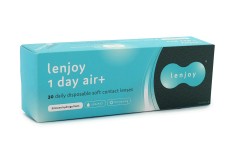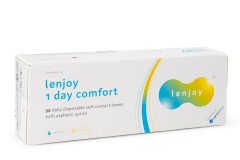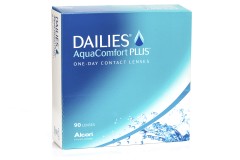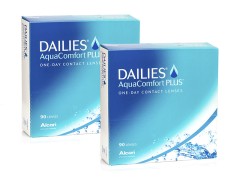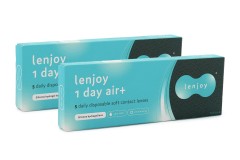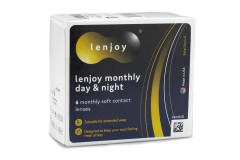How to read your contact lens prescription and parameters

Want to get contact lenses? You should first know the parameters found in the prescription your eye doctor or optometrist gave you after your eye test.
Please note that the data provided by your eye care practitioner should not be over a year old, as the parameters of the eyes can change with age. Also, it is important to know that contact lens prescriptions and glasses prescriptions are not the same.
- The contact lens parameters you need to know
- How to determine a contact lens prescription?
- The difference between a contact lens and spectacle prescription
- Additional information on a contact lens package
- Not every contact lens brand suits each patient's needs
- Summary
The contact lens parameters you need to know
Curvature (BC)
The base curve of a contact lens describes the curvature of the lens in millimeters, to provide the highest comfort while wearing lenses, i.e. how well the lens attaches to your eye. Normally these parameters are between 8–10 mm.
Dioptres / Sphere (D/dpt./S/SPH/PWR)
Sphere is the power of the contact lens. The unit of measure for sphere power is a diopter, or D. In general the spherical power of a lens is indicated with a plus sign (+) for hyperopia and a minus sign (-) for myopia.
Average (DIA)
This value is the diameter (or size) of the lens. Soft contact lenses have a larger diameter from 13.00 to 15.00 mm than hard contact lenses from 9 to 10 mm.
Cylinder (CYL)
The cylinder value is needed for the manufacture of contact lenses for astigmatism. It is a negative value, which makes any correction for the curvature of the cornea.
Axis (A/ACH/AXIS/AX)
The axis is required for astigmatism as a supplement to the contact lens with cylinder. It describes the exact position of the curvature on the cornea and is given in a range of 0° – 180°. Please note that, from a manufacturer's prespective, 0 ° degrees are also written as 180 ° . The number 90 means the vertical position of the eye, and the number 180 corresponds to the horizontal meridian.
Addition (ADD)
ADD is the difference between the dioptric value of the far vision and the dioptric value of the near vision. Values up to 1.25 are regarded as low, up to 2.00 as average and up to 3.00 as high.
How to determine a contact lens prescription?
The contact lens values are determined by an Optician or Ophthalmologist using various tests and measuring methods. Only with an accurate prescription can you buy the right lenses. It is important that all parameters are checked for accuracy every 6–12 months. Your eyesight will change throughout your life, so adjustment is important. If you feel that your vision has changed, you should immediately re-evaluate your contact lens values.
The difference between contact lens prescriptions and glasses prescriptions
Glasses lenses are worn about 12 millimetres in front of the eyes, while contact lenses are placed directly on the surface of the eye. If you wear both, you need to have two different prescriptions so that you enjoy perfect vision whether you're wearing your lenses or glasses.
When ordering lenses or glasses online, be careful not to mix up the prescriptions. Also, the method of measurement for glasses and contact lenses differs slightly, as the distance between the eyes must be measured for the glasses prescription.
Additional information on a contact lens package
In addition to your eyes' essential values, you will find the water content on the package of your contact lenses, as well as the oxygen permeability.
The drier your eyes are, the lower the water content of the contact lens should be. Contact lenses with a high water content draw out water from the eye when worn for a long time, potentially causing dryness.
Pay attention to the right material for you.
Hydrogel contact lenses have a high water content, which evaporates quickly and thus draws a lot of moisture out of the tear film. The result: the eye dries out more quickly. If you have dry eyes, you should therefore opt for silicone hydrogel lenses, as these offer good oxygen permeability and require 20% less water.
The oxygen permeability is indicated by ''Dk/''. The longer you want to wear your lenses, the more oxygen permeable they should be. If the value is too low, sensitive eyes may experience redness, itching and burning.
Not every contact lens brand suit each patient's needs
Just like with shoes and clothing, the units of measure and condition for contact lenses may vary according to the manufacturer. Therefore it is possible that you might have to re-touch your parameters, when changing brand and you are strongly advised to consult an optician, when doing so.
Summary
| Contact lens parameters | Unit of measurement | Abbreviation | More information |
|---|---|---|---|
| Dioptres | dioptre | PWR, D, SPH, dpt | from –30.00 to +30.00 |
| Curvature | millimeter | BC | from 8.00 to10.00 |
| Average | millimeter | DIA | from 13.00 to 15.00 |
| Cylinder | dioptre | CYL, ZYL | from –0.25 to –10.00, toric contact lenses |
| Cylinder axis | degree | A, AX, AXIS | from 0 to 180, toric contact lenses |
| Addition | dioptre | ADD | from 1.00 to 3.00, multifocal lenses |
Don't hesitate to contact us for advice. Call us for free on 180 081 4141 or send us an email.


